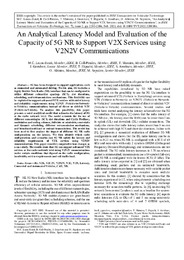Por favor, use este identificador para citar o enlazar este ítem:
https://hdl.handle.net/11000/30152Registro completo de metadatos
| Campo DC | Valor | Lengua/Idioma |
|---|---|---|
| dc.contributor.author | Lucas-Estañ, M. Carmen | - |
| dc.contributor.author | Coll-Perales, Baldomero | - |
| dc.contributor.author | Shimizu, Takayuki | - |
| dc.contributor.author | Gozalvez, Javier | - |
| dc.contributor.author | Higuchi, Takamasa | - |
| dc.contributor.author | Avedisov, Sergei | - |
| dc.contributor.author | Altintas, Onur | - |
| dc.contributor.author | Sepulcre, Miguel | - |
| dc.contributor.other | Departamentos de la UMH::Ingeniería de Comunicaciones | es_ES |
| dc.date.accessioned | 2023-11-14T08:55:59Z | - |
| dc.date.available | 2023-11-14T08:55:59Z | - |
| dc.date.created | 2022-09 | - |
| dc.identifier.citation | Journals & Magazines IEEE Transactions on Vehicula... Vol.: 72 nº: 2 | es_ES |
| dc.identifier.issn | 1939-9359 | - |
| dc.identifier.issn | 0018-9545 | - |
| dc.identifier.uri | https://hdl.handle.net/11000/30152 | - |
| dc.description.abstract | 5G has been designed to support applications such as connected and automated driving. To this aim, 5G includes a highly flexible New Radio (NR) interface that can be configured to utilize different subcarrier spacings (SCS), slot durations, scheduling, and retransmissions mechanisms. This flexibility can be exploited to support advanced V2X services with strict latency and reliability requirements using V2N2V (Vehicle-to-Network-to-Vehicles) communications instead of direct or sidelink V2V (Vehicle-to-Vehicle). To analyze this possibility, this paper presents a novel analytical model that estimates the latency of 5G at the radio network level. The model accounts for the use of different numerologies (SCS, slot durations and Cyclic Prefixes), modulation and coding schemes, full-slots or mini-slots, semi-static and dynamic scheduling, different retransmission mechanisms, and broadcast/multicast or unicast transmissions. The model has been used to first analyze the impact of different 5G NR radio configurations on the latency. We then identify which radio configurations and scenarios can 5G NR satisfy the latency and reliability requirements of V2X services using V2N2V communications. This paper considers cooperative lane changes as a case study. The results show that 5G can support advanced V2X services at the radio network level using V2N2V communications under certain conditions that depend on the radio configuration, bandwidth, service requirements and cell traffic load. | es_ES |
| dc.format | application/pdf | es_ES |
| dc.format.extent | 14 | es_ES |
| dc.language.iso | eng | es_ES |
| dc.publisher | IEEE | es_ES |
| dc.rights | info:eu-repo/semantics/openAccess | es_ES |
| dc.rights | Attribution-NonCommercial-NoDerivatives 4.0 Internacional | * |
| dc.rights.uri | http://creativecommons.org/licenses/by-nc-nd/4.0/ | * |
| dc.subject | 5G | es_ES |
| dc.subject | V2X | es_ES |
| dc.subject | V2C2V | es_ES |
| dc.subject | V2N2V | es_ES |
| dc.subject | V2C | es_ES |
| dc.subject | V2N | es_ES |
| dc.subject | Latency | es_ES |
| dc.subject | Connected and Automated Vehicles | es_ES |
| dc.subject | CAV | es_ES |
| dc.subject | NR | es_ES |
| dc.subject.other | CDU::6 - Ciencias aplicadas::62 - Ingeniería. Tecnología::621 - Ingeniería mecánica en general. Tecnología nuclear. Electrotecnia. Maquinaria::621.3 - Ingeniería eléctrica. Electrotecnia. Telecomunicaciones | es_ES |
| dc.title | An Analytical Latency Model and Evaluation of the Capacity of 5G NR to Support V2X Services Using V2N2V Communications | es_ES |
| dc.type | info:eu-repo/semantics/article | es_ES |
| dc.relation.publisherversion | https://doi.org/10.1109/TVT.2022.3208306 | es_ES |

Ver/Abrir:
TVT2023_LucasColl_Latency Model 5G NR V2N2V (2).pdf
759,48 kB
Adobe PDF
Compartir:
 La licencia se describe como: Atribución-NonComercial-NoDerivada 4.0 Internacional.
La licencia se describe como: Atribución-NonComercial-NoDerivada 4.0 Internacional.
.png)